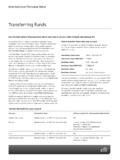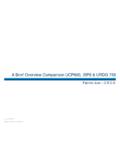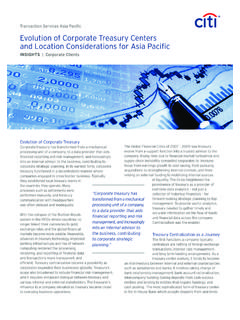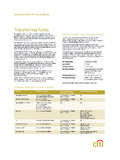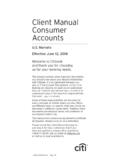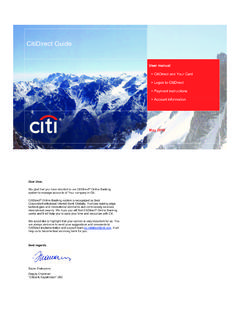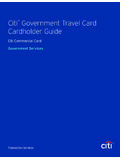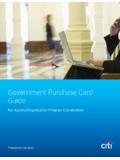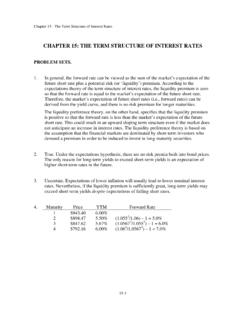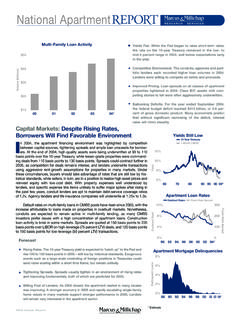Transcription of Rising rates and the effect on credit spreads - Citibank
1 March 2013 Rising rates and the effect on credit spreads What would happen if rates were to rise by year-end? This question might be one of the main concerns in the minds of investors. In the US, there is some evidence of a recovery, and Citi analysts are cautiously optimistic despite headwinds from debt ceiling negotiations and the imminent sequestration. Although the Federal Reserve (Fed) has put short-end rate hikes on hold until the unemployment rate reaches , there is a possibility that long-end rates may rise on the back of increasing investor optimism. Indeed, US Treasury 10-year yields have risen above 2% on several occasions recently, and Citi analysts expect the year-end level to be at Rising rates and the effect on credit spreads So what will this mean for credit spreads ?
2 Will they be compressed, or will corporate yields rise in tandem, keeping spreads constant or making them go slightly wider? How should investors position themselves for Rising rates ? Figure 1: The 3 regimes of relationship between credit spreads and 10-year US treasury yields Source: Markit, Yieldbook, Citi Research as of 20 February 2013. (CDX IG CDX Investment Grade Index; Citi US BIG OAS Citi US Broad Investment Grade Option-Adjusted Spread; US 10Y TSY US 10-year Treasury yield) Three regimes with regard to the rate/ credit spread relationship Looking at the relationship between daily investment-grade bond spreads and US Treasury 10-year yields from 2004 till date, there is a slightly negative relationship between 10-year rates and spread levels, although not strong enough for rates to influence credit spreads significantly.
3 To understand the relationship further, Citi analysts identify three distinct regimes: a pre-crisis period, a crisis period and a post-crisis period, as shown in Figure 1. The dependency of credit spreads on the level of rates was strong during the period of the financial crisis (2008-2009) due to the flight-to-quality phenomenon, but weaker in the pre- and post-crisis periods. In addition, the factors driving credit spreads appear to behave differently in pre- and post-crisis periods. The main driver during the crisis period was the level of US Treasury 10-year yields which have a strong negative correlation with credit spreads , as would be expected. As10-year yields dropped, credit spreads kept widening in response to the flight-to-quality exhibited by investors.
4 During non-crisis periods, inflation expectations and the shape of the yield curve become important. The influence of these factors is different during pre- and post-crisis periods. Past performance is no guarantee of future results. Investment products are (i) not insured by any government agency; (ii) not a deposit or other obligation of, or guaranteed by, the depository institution; and (iii) subject to investment risks, including possible loss of the principal amount invested. For more important information see end page. Rising rates and the effect on credit spreads In the pre-crisis period (2004-July 2007) the old normal the main factor influencing credit spreads was the slope of the yield curve, while inflation expectations did not contribute greatly.
5 During this period, the US economy was growing strongly, and in response, the Fed raised the funds rate from a low of 1% (post-2001 recession) to This flattened the yield curve considerably while credit spreads tightened in response to a growing economy. In contrast, looking at the results for the post-crisis phase the new normal credit spreads are mainly influenced by inflation expectations. The slope of the yield curve (or the difference between the 3-month and 10-year Treasury yields, as we have defined it) has become less relevant, since the short end of the curve has been artificially kept low by the Fed, which implies that only the long end (10-year) is important in determining the slope.
6 What will happen if 10-year US Treasury yields were to rise to by year end? On balance, Citi analysts believe that we may end the year still in the new normal regime, given that the current economy is still suffering from overcapacity and while deflation fears have subsided, we could continue to see weak economic growth. Based on Citi rates analysts projections, the 2-year US treasury rate is anticipated to end the year at (up from the current ), and 10-year rate to reach by the end of 2013 (assuming an optimistic growth scenario that results in a unemployment rate by 2014). If US 10-year treasury yield rise to by year-end, Citi s models show that cash investment grade spreads should tighten to 116 bps and synthetic spreads to 76 bps.
7 Indeed, Citi analysts believe that a modest rise in rates and inflation expectations should produce a modest tightening in credit spreads . Euro-Area ECB may cut rates by another 25 bps Citi analysts expect GDP growth of in 2013 and in 2014. After the contraction in 4Q12 GDP ( QoQ), a stabilisation in GDP in 1Q13 looks likely, but a recovery is not expected in the course of the year. Sentiment data show that the gap between Germany and the rest of the euro area remains large, giving little evidence of positive contagion from improving financial markets into real economic activity in the periphery countries. In Citi s view, the European Central Bank (ECB) is unlikely to provide Fed-style guidance that rates will stay low.
8 In the near-term, the ECB is also unlikely to introduce quantitative easing measures, while the activation of the OMT (open market transactions) depends on government action. With ongoing economic weakness and modest reduction of excess liquidity because of the 3Y LTRO repayments, the ECB may cut the refinancing rate by 25 bps in 2Q. Another cut to is anticipated by the year end, probably joined by a cut in the deposit rate to From an equity perspective, it made sense to issue equity over debt given the difference between the earnings yield and BBB credit between 1989 and 2001. From 2001 that changed and equity has been consistently higher-yielding than credit the de-equitisation era.
9 The gap today is wider than anytime during the 2003-2007 period. Indeed, CEOs have been cautious since 2008-09. Now, conditions are in place for an increase in corporate activity. More broadly, corporate re-leveraging is expected to pick up. This remains a key part of Citi s re-rating call for equities. Overall, Citi analysts think we are at the start, not the end, of an M&A and re-leveraging cycle. Chart 1: S&P 500 Index Chart 2: Dow Jones Stoxx 600 Index *Denotes cumulative performance Performance data as of 28 February 2013 Source: Bloomberg *Denotes cumulative performance Performance data as of 28 February 2013 Source: Bloomberg United States Fed may begin to phase down QE late in 2H13 Support for expansion has improved with widespread hiring, more effective monetary accommodation as reflected in buoyant financial markets, and a strengthening contribution from housing.
10 Short-term volatility due in part to weather distortions has provided an extra lift to 1Q13 GDP but higher taxes are likely to weigh on consumers and overall growth through mid-year. Citi analysts do not expect last minute action to avert scheduled sequestration but delays in implementation could likely allow for modifications that may limit fiscal drag. The Federal Reserve s (Fed) aggressive forward guidance and open-ended bond-buying have yielded the longest stretch of accommodative financial conditions since the late-1990s. The drag from fiscal restraint and policymakers high bar for satisfactory job growth will likely sustain QE at an elevated pace through 1H13 but may begin to taper the pace in 2H13.

